Hamburg Buddhist Studies
Der Buddhismus spielt bei dem Studium der religiösen Ideen Asiens an der Universität Hamburg seit fast 100 Jahren eine prominente Rolle. Mit der Schriftenreihe Hamburg Buddhist Studies möchte das Numata Zentrum für Buddhismuskunde das langjährige Engagement und die Forschungsergebnisse dieser Tradition mit der Forschergemeinschaft und einem breiten Publikum teilen. Die Schriftenreihe wird von der Hamburg University Press bzw. dem Projektverlag herausgegeben und die jeweiligen Bände sind sowohl in gedruckter Form als auch als E-Book erhältlich.
Band 1: Anālayo: The Genesis of the Bodhisattva Ideal
Band 2: Anālayo: The Dawn of Abhidharma
Band 3: Lin/Radich (Hrsg.): A Distant Mirror
Band 4: Silk: Buddhist Cosmic Unity
Band 5: Radich: The "Mahāparinirvāṇa-mahāsūtra" and the Emergence of "Tathāgatagarbha" Doctrine
Band 6: Anālayo: The Foundation History of the Nuns’ Order
Bhikkhu Analayo (Universität Hamburg)
Lucia Dolce (School of Oriental and African Studies, London)
Franz-Karl Ehrhard (Ludwig-Maximilians Universität München)
Mario Poceski (University of Florida, Gainesville, USA)
Petra Kieffer-Puelz (Academy of Sciences and Literature, Mainz)
Band 21:The Dynamic Non-Duality of Dharmadhātu
von Fujii Jun
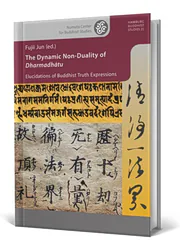
This volume, with contributions from eight scholars, examines the centrality of dharmadhātu and related expressions of ultimate truth within Mahāyāna Buddhism, analyzing them as distinct yet interconnected concepts. Through historical and philosophical inquiry, it explores their roles in addressing conceptual dichotomies such as saṃsāra and nirvāṇa, conditioned and unconditioned dharmas, and traces the development of these ideas across Indian and Chinese Buddhist traditions. Engaging with key sutras and commentarial texts, the study examines dharmadhātu and other truth expressions separately, while highlighting the shared threads that connect them. The analysis reveals the doctrinal implications of these concepts and their relevance within broader Buddhist frameworks. Concise and accessible, this work offers a fresh perspective on the complexity of Buddhist thought, providing readers with a nuanced understanding of these foundational concepts and their historical trajectories.
Fujii Jun, The Dynamic Non-Duality of Dharmadhātu
Elucidations of Buddhist Truth Expressions. Hamburg Buddhist Studies 21, Bochum/Freiburg: projektverlag 2025.
Band 19: Burlesque of the Philosophers: Indian and Buddhist Studies in Memory of Helmut Krasser, Part I and Part II
Vincent Eltschinger, Jowita Kramer, Parimal Patil, Chizuko Yoshimizu (Hrsg.)
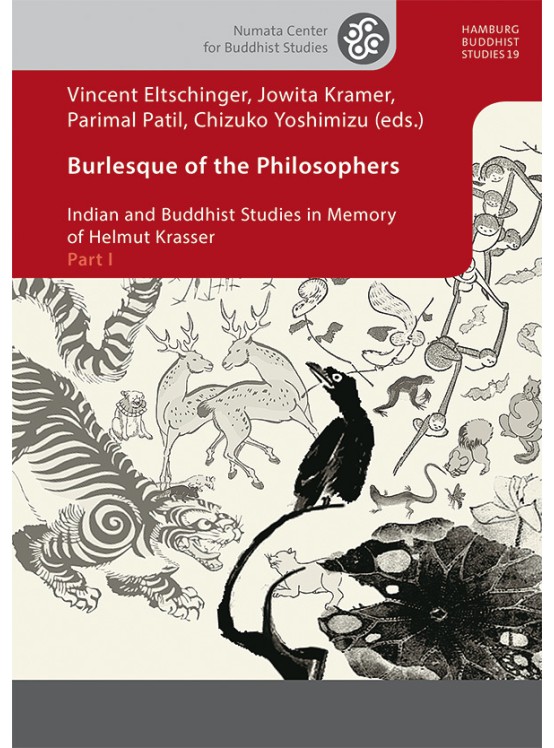
Frei verfügbarkeit als PDF: Part I and Part II
Helmut Krasser, despite tragically passing away much too early in 2014, left his mark on more than one generation of scholars of Indian and Buddhist philosophy. An eminent specialist on the so-called “logico-epistemological tradition,” he devoted his Viennese dissertation and early work to the Buddhist philosopher Dharmottara, before broadening the scope of his research to Dignāga and Dharmakīrti, the tradition’s historical founders. In particular, he examined their ideas on the relationship between logic and soteriology. He also considered the very nature of their texts. Should they be understood as authored philosophical works? Or rather as edited lecture notes of students? Director from 2007 to 2014 of the Institute for the Cultural and Intellectual History of Asia at the Austrian Academy of Sciences, Helmut Krasser left behind a multi-faceted body of work, including editions of ancient Sanskrit manuscripts today found in the Tibetan Autonomous Region that had never before been published. This commemorative volume with more than thirty contributions not only reflects the multiplicity of his interests, it is also evidence of the deep impression he left on all those who met him. It is a document to the faithful friendship and highest respect still held by his friends and colleagues almost ten years after his death.
Vincent Eltschinger, Jowita Kramer, Parimal Patil, Chizuko Yoshimizu (Hrsg.), Burlesque of the Philosophers
Indian and Buddhist Studies in Memory of Helmut Krasser, Part I and Part II. Hamburg Buddhist Studies 19, Bochum/Freiburg: projektverlag 2023.
Band 20: Insight in Perspective. S. N. Goenka and the Emergence of Global Insight Meditation and Mindfulness
von Daniel Stuart
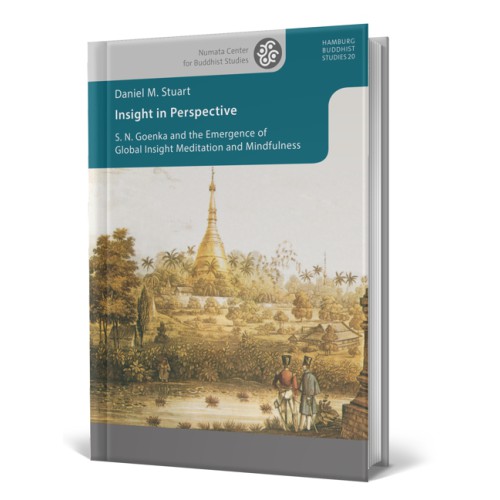
Frei verfügbar als PDF: Link
This monograph interrogates a dominant teleological narrative about the history of modern global insight meditation and mindfulness: namely, that modern mass meditation movements were the inevitable result of the work of a handful of modern reformers who were in large part responding to colonial forces in Asia. Focusing on the figure of S. N. Goenka (1924–2013) and his Burmese lineage, the book redescribes the development of twentieth-century lay-focused insight meditation and mindfulness emergent from Burma (Myanmar). By recovering the historical background, lineage relationships, and practice contexts of Goenka’s teacher, the Burmese lay meditation master Sayagyi U Ba Khin (1899– 1971), the book elucidates the historical dynamics that gave rise to one of the most influential global meditation institutions of the twentieth century. Daniel M. Stuart shows that an appreciation of the cosmological, political, and personal motivations of the meditation teachers in S. N. Goenka’s lineage brings to light occluded aspects of the history of modern global insight meditation.
Daniel Stuart, Insight in Perspective. S. N. Goenka and the Emergence of Global Insight Meditation and Mindfulness. Hamburg Buddhist Studies 20, Bochum/Freiburg: projektverlag 2024.
Band 18: The Reception of Genshin and his Ichijō yōketsu 一乗要決 in Japanese Medieval Buddhism
von Serena Operetto
Frei verfügbar als PDF: Link
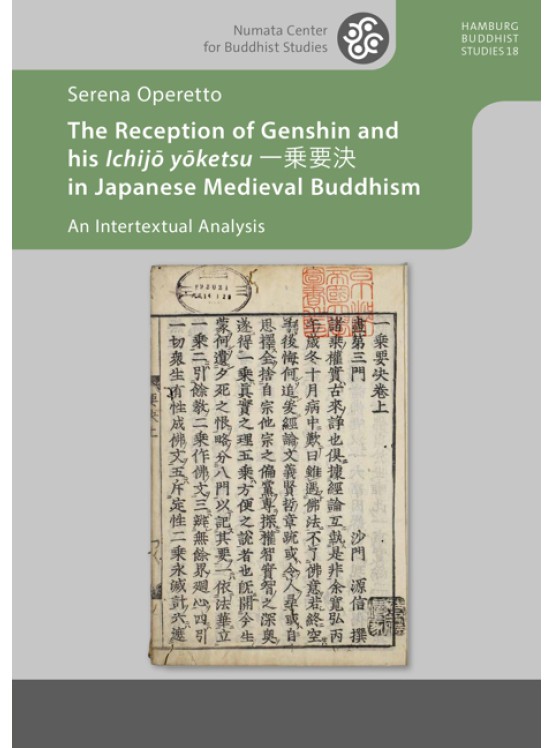
Genshin (源信; 942–1017), also known as Eshin sōzu (恵心僧都) , is one of the most prominent masters of Japanese Tendai Buddhism. This study focuses on one of his seminal works, the Ichijō yōketsu 一乗要決 (Determining the Essentials of the One-vehicle), and evaluates its influence on subsequent representatives of the tradition in the medieval period. It elucidates how Genshin and his most significant writings, i.e. the Ichijō yōketsu and the Ōjōyōshū 往生要集 (The Essentials of Birth in the Pure Land), were understood in the Buddhist milieu of the Japanese Middle Ages. By shedding light how the Ichijō yōketsu was quoted in connection to the sangoku mappō 三国末法 paradigm („decline of the dharma throughout the three countries“ of India, China, and Japan), the present book contributes original and relevant insights into Japanese Buddhism. It primarily takes an intertextual approach, which is carried out with the help of digital resources and tools. Yet another feature is the first English-language translation of the Genshin sōzu den 源信僧都伝 (Biography of the General Vicar Genshin), the oldest full-length biography of Genshin. While the work presents a wealth of new knowledge and hitherto unexplored angles, it does not intend to conclude its matter. Rather, it aims at inspiring further interest in the study of Genshin and his many unexplored works.
Serena Operetto, The Reception of Genshin and his Ichijō yōketsu 一乗要決 in Japanese Medieval Buddhism. Hamburg Buddhist Studies 18, Bochum/Freiburg: projektverlag 2023.
Band 17: The Composition and Transmission of Early Buddhist Texts with Specific Reference to Sutras
von Mark Allon
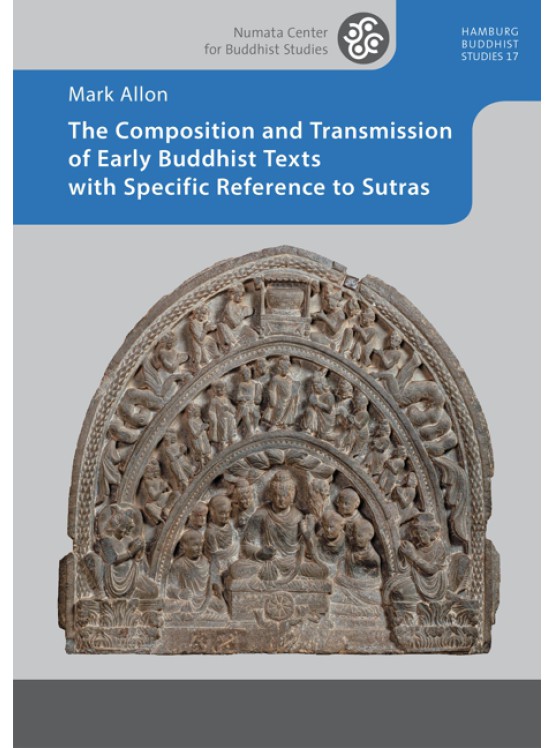
Nun verfügbar als freies PDF: Link
This study discusses the composition and transmission of early Buddhist texts with specific reference to sutra (sutta/sūtra) texts. Based on an initial overview of the stylistic and structural characteristics of these texts and the principles employed in the creation and organization of sutra and verse collections that, I argue, indicate that they were oral compositions that were intended to be memorized and transmitted verbatim, the study focuses on the types of changes that these texts underwent in the course of their transmission, both intentional and unintentional, and the reasons such changes occurred. It then gives an account of the challenges that change, particularly intentional change, must have posed to the oral transmission of fixed texts.
Mark Allon, The Composition and Transmission of Early Buddhist Texts with Specific Reference to Sutras. Hamburg Buddhist Studies 17, Bochum/Freiburg: projektverlag 2021.
Reviews
Sylvia Chan, Canadian Journal of Buddhist Studies, Number 17, 2022 (link to article)
Band 16: Practicescapes and the Buddhists of Baoshan
von Wendi L. Adamek
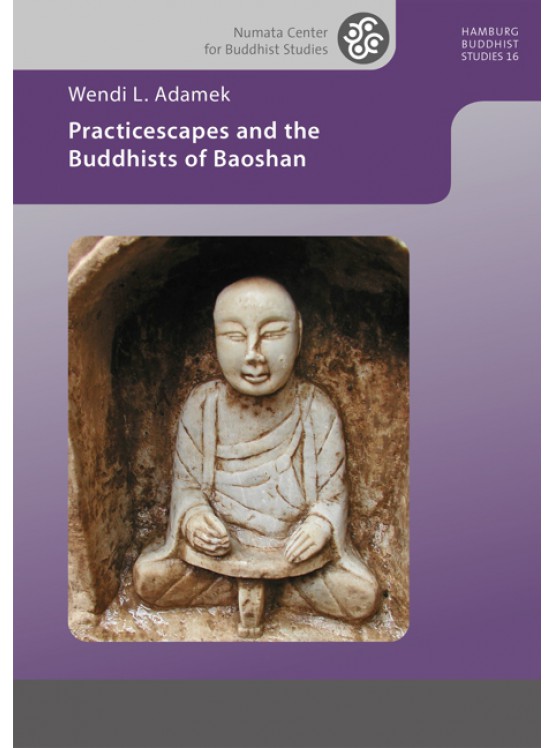
Nun verfügbar als freies PDF: Link
How should one dwell in endtime? In this SPIDER-spun web of a book, Wendi Adamek guides readers to the visual and textual traces left by Buddhist nuns, monks, and devotees on mountainsides in Baoshan, north central China, and through them, the soteriology of Buddhism in the medieval world. The convents have vanished and the stones weathered, but the skillful work in maintaining co-constitutive relations is as palpable as ever. Thoroughly researched and artfully written, this deeply affecting book advances scholarship without leaving the lay reader behind. The comparative insights, theory-work, and appended transcriptions of this definitive study constitute a gift to past, present, and future travelers.
Dorothy Ko, author of The Social Lives of Inkstones: Artisans and Scholars in Early Qing China
Wendi L. Adamek, Practicescapes and the Buddhists of Baoshan. Hamburg Buddhist Studies 14, Bochum/Freiburg: projektverlag 2021.
Band 15: The Buddhist Nuns' Ordination in the Tibetan Canon
von Carola Roloff
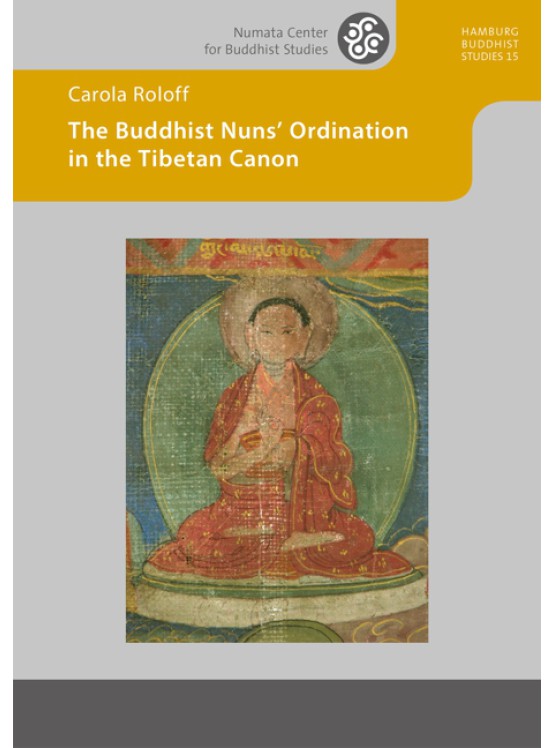
Nun verfügbar als freies PDF: Link
Professor Roloff has offered an enormous gift to Vinaya scholars, to scholars of Tibetan Buddhism, to the monastic community, to scholars of women in religion, and most of all to Buddhist women both lay and monastic with the publication of Buddhist Nuns‘ Ordination in the Tibetan Canon. The editions and translations of important texts concerning the ordination of women are erudite, comprehensive and clear. They will be invaluable primary resources for anyone interested in the issue of the restoration of the Tibetan nuns’ full ordination lineage. Prof. Roloff’s analysis of the legal and religious issues, and her argument for the procedure for the restoration of this lineage is meticulous and convincing, setting a new standard for argument in this important debate.
Jay L Garfield, Doris Silbert Professor in the Humanities and Professor of Philosophy and Buddhist Studies, Smith College and the Harvard Divinity School
An academic book to be proud of for this century and centuries to come. Bhikkhunīs around the world offer deep gratitude to her work.
Venerable Bhikkhuni Dhammanandā (Dr. Chatsumarn Kabilsingh), the first Theravāda bhikkhunī in Thailand and Professor Emeritus, Thammasat University
Amidst a wealth of discussions on Buddhist nuns’ ordination, this edition and translation of a fascinating text on rituals and regulations in the Tibetan tradition presents a much-needed exploration of all the salient issues. Leaving no stone unturned, it lays the foundation for future research and is essential reading for anyone with an interest in gender and institutions.
Prof. Dr. Ann Heirman, Head of the Department of Languages and Cultures and the Centre for Buddhist Studies, Ghent University
This is an important book. It will provide a solid foundation for any future discussion of what might be an unnecessarily complicated issue. The careful critical editions of the canonical sources involved are especially welcome.
Gregory Schopen, Distinguished Professor Emeritus, Department of Asian Languages & Cultures, UCLA
Carola Roloff, The Buddhist Nuns' Ordination in the Tibetan Canon. Hamburg Buddhist Studies 15, Bochum/Freiburg: projektverlag 2021.
Band 14: The Da zhidu lun 大智度論 (*Mahāprajñāpāramitopadeśa) and the History of the Larger Prajñāpāramitā
von Stefano Zacchetti
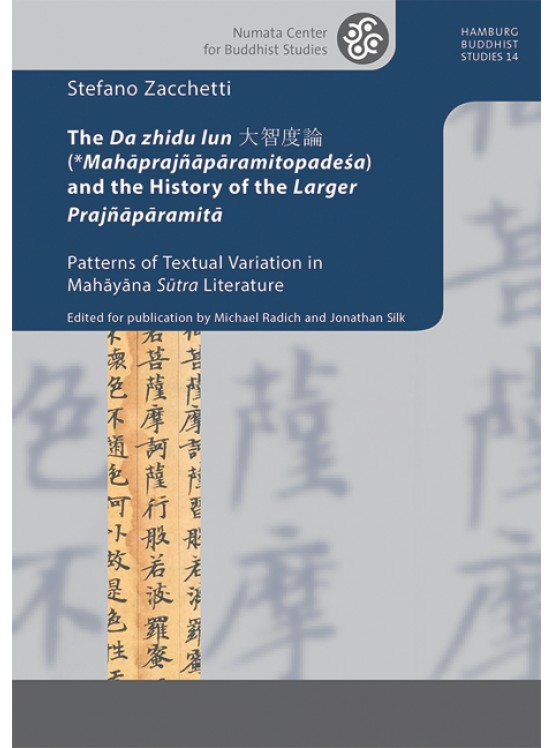
Nun verfügbar als freies PDF: Link
In his final monograph, Stefano Zacchetti analyzes the Da zhidu lun’s complex relation to a number of Larger Prajñāpāramitā texts. The evidence presented here reveals a complementary, even symbiotic relation between root text and commentary, and puts into relief processes of stabilization, consolidation, and canonization. The reader is afforded precious insights into the textual history of the Da zhidu lun, of the Larger Prajñāpāramitā literature as a whole, and of the general patterns of formation, transmission, exegesis, and recension of Mahāyāna Buddhist texts.
Stefano Zacchetti, The Da zhidu lun 大智度論 (*Mahāprajñāpāramitopadeśa) and the History of the Larger Prajñāpāramitā. Hamburg Buddhist Studies 14, Bochum/Freiburg: projektverlag 2021.
Band 13: Buddhism and Scepticism
von Oren Hanner (ed.)
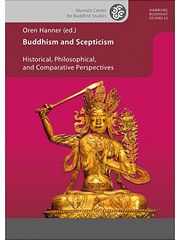
Nun verfügbar als freies PDF: Link
Is Buddhism's attitude towards accepted forms of knowledge sceptical? Are Pyrrhonian scepticism and classical Buddhist scholasticism related in their respective applications and expressions of doubt? In what way and to what degree is Critical Buddhism an offshoot of modern scepticism? Questions such as these as well as related issues are explored in the present collection, which brings together examinations of systematic doubt in the traditions of Buddhism from a variety of perspectives. What results from the perceptive observations and profound analytical insights of the seven essays is a rich and multi-faceted picture of two families of philosophical systems––scepticism and Buddhism––that seem both akin and at odds, both related and distant at the same time.
Oren Hanner (ed), Buddhism and Scepticism: Historical, Philosophical, and Comparative Perspectives. Hamburg Buddhist Studies 13, Bochum/Freiburg: projektverlag 2020.
Reviews
Davey K. Tomlinson, Philosophy East and West, Volume 71, Number 4, October 2021, pp. 1-7 (PDF of Article)
Peter Hofmann, Zeitschrift für Theologie und Philosophie, Volume 144, Number 2, 2022, online (DOI: https://doi.org/10.35070/ztp.v144i2.3807)
Band 12: Fleischverzehr und Vegetarismus im indischen Buddhismus
von Lambert Schmithausen
Nun verfügbar als freie PDFs: Band 1, Band 2, Band 3
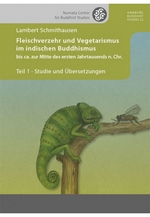
Lambert Schmithausens dreiteilige Studie „Fleischverzehr und Vegetarismus im indischen Buddhismus“ ist im Juni 2020 im projektverlag erschienen. Das umfassende Werk beschäftigt sich mit dem Verhältnis des indischen Buddhismus zum Fleischverzehr von seinen Ursprüngen bis zum 5. Jahrhundert n. Chr. In dem Buch werden insbesondere die Gedanken, Argumente und Motive der ersten dezidiert (lacto-)vegetaristischen buddhistischen Bewegung herausgearbeitet, wie sie in zahlreichen Textzeugen im Buddhismus des Mahayana bezeugt sind.
Die Studie wird ergänzt durch kritische Editionen und Übersetzungen der relevanten buddhistischen Texte sowie einen Band mit Endnoten.
Lambert Schmithausen, Fleischverzehr und Vegetarismus im indischen Buddhismus bis ca. zur Mitte des ersten Jahrtausends n. Chr., 3 Bände, Hamburg Buddhist Studies 12, Bochum/Freiburg: projektverlag 2020.
Teil 1: Studie und Übersetzungen
Band 11: The Life and Works of mKhan-po gZhan-dga’ (1871–1927)
von Achim Bayer
Nun verfügbar als freies PDF: Link
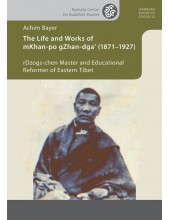 The rDzogs-chen master and scholar mKhan-po gZhan-dga’ is perhaps best known for being unknown. Raised in the vast plains of northern Khams, he came to inherit the scholarly tradition of rDza dPal-sprul Rin-po-che and revitalize the college belonging to rDzogs-chen monastery, in the shadow of the snowcapped Ru-dam mountain range. In the spirit of the non-sectarian movement, students from all traditions of Khams came to learn from him, some following him as he moved on to teach near the capital sDe-dge dGon-chen, to become the tutor of the Tā’i Si-tu incarnation at dPal-spungs and to establish the college at mKhyenbrtse’i-dbang-po’s estate near rDzong-gsar. In this way, this scion of nomad nobility eventually became a teacher at the most important centres of the settled communities, a rNying-ma-pa established and respected among the most exalted Sa-skya-pa scholars. gZhan-dga’s specific curriculum led to a wave of colleges being founded by his disciples in the rNying-ma, bKa’-brgyud and Sa-skya traditions, effecting a leap in higher education all over the Tibetan plateau.
The rDzogs-chen master and scholar mKhan-po gZhan-dga’ is perhaps best known for being unknown. Raised in the vast plains of northern Khams, he came to inherit the scholarly tradition of rDza dPal-sprul Rin-po-che and revitalize the college belonging to rDzogs-chen monastery, in the shadow of the snowcapped Ru-dam mountain range. In the spirit of the non-sectarian movement, students from all traditions of Khams came to learn from him, some following him as he moved on to teach near the capital sDe-dge dGon-chen, to become the tutor of the Tā’i Si-tu incarnation at dPal-spungs and to establish the college at mKhyenbrtse’i-dbang-po’s estate near rDzong-gsar. In this way, this scion of nomad nobility eventually became a teacher at the most important centres of the settled communities, a rNying-ma-pa established and respected among the most exalted Sa-skya-pa scholars. gZhan-dga’s specific curriculum led to a wave of colleges being founded by his disciples in the rNying-ma, bKa’-brgyud and Sa-skya traditions, effecting a leap in higher education all over the Tibetan plateau.
The reason for gZhan-dga’s fame was at the same time the reason for his invisibility: in order to provide a curriculum for students from all Tibetan Buddhist denominations, he had written his textbooks based on the explanations of Indian Buddhist masters exclusively, without mixing them with even a hair (spu tsam yang ma bsres par) of specific Tibetan opinions, including his own.
gZhan-dga’s activity unfolded in the network of social and spiritual issues of his time, issues as diverse as the relation between Pramāņa and Madhyamaka, the royal succession of sDe-dge and the war of 1908/09, the debates about gZhan-stong and the interpretation of cittamātra, the succession of the mKhyenbrtse estate, the role of monasticism in Khams-pa society, the enthronement of Dil-mgo mKhyen-brtse Rin-po-che, the British-backed offensive in sDe-dge near the end of WWI, the ethical and political dimensions of debate, the rDzogs-chen lineage of ’Bo-gangs-dkar Rin-po-che, rDza dPal-sprul’s Klong chen snying thig lineage(s), Sanskrit studies in Khams, the revival of Go-rams-pa studies, and, at the very peak, Klong-chen-pa’s interpretation of Madhyamaka. Readers will find musings on these issues interwoven with gZhan-dga’s biography and a catalogue of his works.
Achim Bayer, The Life and Works of mKhan-po gZhan-dga’ (1871–1927) Hamburg Buddhist Studies 11, Bochum/Freiburg: Projektverlag 2019.
Band 10: Communities of Memory and Interpretation
von Mario Poceski (ed.)
Nun verfügbar als freies PDF: Link
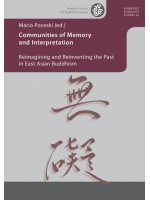
The five studies in this volume show unprecedented efforts by each individual contributor to engage in micro-historical research on categories and themes such as lineage, hagiography, and sacred texts in different historical contexts. (Jiang Wu, University of Arizona)
Communities of Memory and Interpretation is a fascinating collection of wellresearched essays that all feature important methodological reflections in addition to detailed and insightful textual analysis or fieldwork scholarship. The volume consistently highlights the theme of how the respective traditions developed a sense of legitimacy and legacy based on canonicity and the various repetitions and reversals of at times disturbing or perplexing paradigms and exegetical strategies to establish and maintain lineal identity and authority. (Steven Heine, Florida International University)
Mario Poceski (ed.), Communities of Memory and InterpretationHamburg Buddhist Studies 10, Bochum/Freiburg: Projektverlag 2018.
Das Inhaltsverzeichnis und die Einführung können hier heruntergeladen werden.
Band 9: Rules of Engagement
von Susan Andrews / Jinhua Chen / Cuilan Liu (eds.)
Nun verfügbar als freies PDF: Link
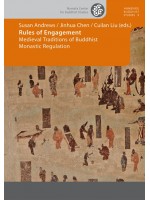 Recent years have seen heightened interest in the ritual, juridical, and generally practical aspects of the Buddhist tradition. The contributions to Rules of Engagement build on this trend while venturing beyond the established boundaries of discourse in specialized academic disciplines, presenting state-of-the-art research on the vinaya in all of its breadth and depth. They do so not only by tracing Buddhist textual traditions but also by showcasing the vast variety of practices that are the object of such regulations and throw a new light on the social implications such protocols have had in South, Central, and East Asia.
Recent years have seen heightened interest in the ritual, juridical, and generally practical aspects of the Buddhist tradition. The contributions to Rules of Engagement build on this trend while venturing beyond the established boundaries of discourse in specialized academic disciplines, presenting state-of-the-art research on the vinaya in all of its breadth and depth. They do so not only by tracing Buddhist textual traditions but also by showcasing the vast variety of practices that are the object of such regulations and throw a new light on the social implications such protocols have had in South, Central, and East Asia.
Susan Andrews / Jinhua Chen / Cuilan Liu (eds.), Rules of EngagementHamburg Buddhist Studies 9, Bochum/Freiburg: Projektverlag 2017.
Das Inhaltsverzeichnis kann hier heruntergeladen werden.
Band 8: Buddhapada and the Bodhisattva Path
von Bhikkhu Anālayo
Nun verfügbar als freies PDF: Link
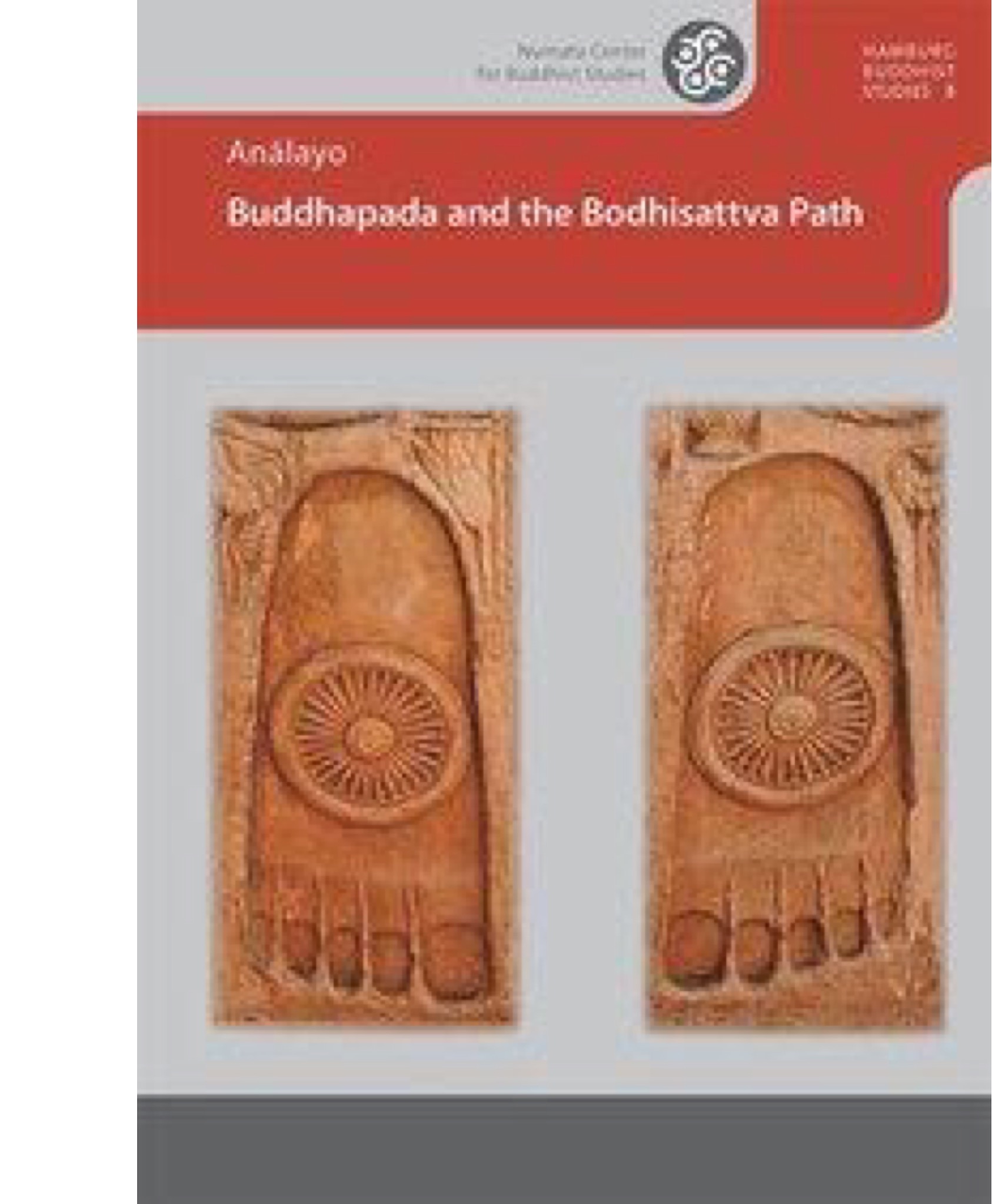 Building on his ground-breaking The Genesis of the Bodhisattva Ideal, with the present monograph Bhikkhu Anālayo approaches a closely related topic from the perspective of the bodily dimension as evident in the thirty-two marks with which, according to tradition, the Buddha was endowed. The study begins by proposing that a cross-fertilization between text and art has influenced the conception of one of these marks, namely the wheel-marks on the soles of the Buddha’s feet. By way of a comparative study of the early discourses, Anālayo proceeds to show how the thirty-two marks – initially nearly imperceptible features – came to be more clearly visible and acquired salvific power. Eventually, he argues, these turned into a psychosomatic chart for the bodhisattva path and thereby set a precedent for the prediction (commonplace in later Buddhist doctrine) that assures an aspiring bodhisattva of becoming a Buddha in the future.
Building on his ground-breaking The Genesis of the Bodhisattva Ideal, with the present monograph Bhikkhu Anālayo approaches a closely related topic from the perspective of the bodily dimension as evident in the thirty-two marks with which, according to tradition, the Buddha was endowed. The study begins by proposing that a cross-fertilization between text and art has influenced the conception of one of these marks, namely the wheel-marks on the soles of the Buddha’s feet. By way of a comparative study of the early discourses, Anālayo proceeds to show how the thirty-two marks – initially nearly imperceptible features – came to be more clearly visible and acquired salvific power. Eventually, he argues, these turned into a psychosomatic chart for the bodhisattva path and thereby set a precedent for the prediction (commonplace in later Buddhist doctrine) that assures an aspiring bodhisattva of becoming a Buddha in the future.
Anālayo, Buddhapada and the Bodhisattva Path. Hamburg Buddhist Studies 8, Bochum/Freiburg: Projektverlag 2017.
Band 7: The Eighth Karmapa’s Life and his Interpretation of the Great Seal
von Jim Rheingans
Nun verfügbar als freies PDF: Link
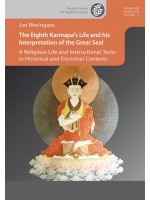 This book investigates Mikyö Dorje’s biographies and carries out case studies of some of his mahāmudrā (Great Seal) teachings, Buddhist instructions for the acquisition of meditative insight. After surveying a variety of textual sources for the study of the Karmapa’s life and works, this book shows how he developed into one of the most productive scholars of his tradition, who, located within the shifting religious and political hegemonies of his time, managed to acquire a status of singular importance to his school. Rheingans then goes on to analyse Mikyö Dorje’s mahāmudrā teachings by examining selected texts that contain such instructions in historical and doctrinal context. This study contends that the Kagyüpa mahāmudrā constitutes less a static system than an independent key instruction to be adapted by the guru to different students’ requirements and are thus chiefly characterised by didactic pragmatism.
This book investigates Mikyö Dorje’s biographies and carries out case studies of some of his mahāmudrā (Great Seal) teachings, Buddhist instructions for the acquisition of meditative insight. After surveying a variety of textual sources for the study of the Karmapa’s life and works, this book shows how he developed into one of the most productive scholars of his tradition, who, located within the shifting religious and political hegemonies of his time, managed to acquire a status of singular importance to his school. Rheingans then goes on to analyse Mikyö Dorje’s mahāmudrā teachings by examining selected texts that contain such instructions in historical and doctrinal context. This study contends that the Kagyüpa mahāmudrā constitutes less a static system than an independent key instruction to be adapted by the guru to different students’ requirements and are thus chiefly characterised by didactic pragmatism.
Jim Rheingans, The Eighth Karmapa’s Life and his Interpretation of the Great Seal. Hamburg Buddhist Studies 7, Bochum/Freiburg: Projektverlag 2017.
Band 6: The Foundation History of the Nuns’ Order
von Bhikkhu Anālayo
Nun verfügbar als freies PDF: Link
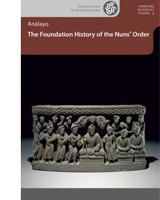 This book is a companion to Bhikkhu Anālayo’s previous studies of the Genesis of the Bodhisattva Ideal and the Dawn of Abhidharma. In the present book he examines the foundation history of the Buddhist order of nuns, based on a detailed study of the canonical accounts of this event preserved in Chinese, Pāli, Sanskrit, and Tibetan. Anālayo investigates how the different and at times conflicting parts of the textual account of this particular episode gradually evolved to constitute the foundation history in the way in which it is now extant. His findings put into perspective the Buddha’s refusal to found an order of nuns as well as the prediction that the going forth of women supposedly spells decline for the whole Buddhist tradition, showing how these elements would have arisen and then become part of the foundation history.
This book is a companion to Bhikkhu Anālayo’s previous studies of the Genesis of the Bodhisattva Ideal and the Dawn of Abhidharma. In the present book he examines the foundation history of the Buddhist order of nuns, based on a detailed study of the canonical accounts of this event preserved in Chinese, Pāli, Sanskrit, and Tibetan. Anālayo investigates how the different and at times conflicting parts of the textual account of this particular episode gradually evolved to constitute the foundation history in the way in which it is now extant. His findings put into perspective the Buddha’s refusal to found an order of nuns as well as the prediction that the going forth of women supposedly spells decline for the whole Buddhist tradition, showing how these elements would have arisen and then become part of the foundation history.
Anālayo, The Foundation History of the Nuns’ Order. Hamburg Buddhist Studies 6, Bochum/Freiburg: Projektverlag 2016.
Band 5: The "Mahāparinirvāṇa-mahāsūtra" and the Emergence of "Tathāgatagarbha" Doctrine
von Michael Radich
Nun verfügbar als freies PDF: Link
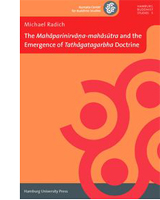 Famously, tathāgatagarbha doctrine holds that every sentient being has within the body a womb for Buddhas, or an embryonic Buddha – the potential for full buddhahood. Previous scholars have seen this doctrine as originating in the Tathāgatagarbha-sūtra. In this book, Michael Radich argues that rather, the Mahāparinirvāṇa-mahāsūtra is most likely our earliest extant tathāgatagarbha text. Radich then argues that tathāgatagarbha ideas originated as part of a wider pattern of docetic Buddhology – ideas holding that Buddhas are not really as they appear. Buddhist docetic texts are clearly troubled by the notion that Buddhas could have flesh-and-blood human mothers. The Mahāparinirvāṇa-mahāsūtra is one such text, and tathāgatagarbha functions as a better substitute for imperfect human maternity: rather than a putrid, painful human womb, buddhahood springs from a “womb” inherent in every sentient being, which promises final liberation from flesh altogether. This book should interest readers concerned with the history of Buddhist ideas, gender in Buddhism, the early Mahāyāna, the cult of the Buddha’s relics, and relations between Buddhist ideas and practice.
Famously, tathāgatagarbha doctrine holds that every sentient being has within the body a womb for Buddhas, or an embryonic Buddha – the potential for full buddhahood. Previous scholars have seen this doctrine as originating in the Tathāgatagarbha-sūtra. In this book, Michael Radich argues that rather, the Mahāparinirvāṇa-mahāsūtra is most likely our earliest extant tathāgatagarbha text. Radich then argues that tathāgatagarbha ideas originated as part of a wider pattern of docetic Buddhology – ideas holding that Buddhas are not really as they appear. Buddhist docetic texts are clearly troubled by the notion that Buddhas could have flesh-and-blood human mothers. The Mahāparinirvāṇa-mahāsūtra is one such text, and tathāgatagarbha functions as a better substitute for imperfect human maternity: rather than a putrid, painful human womb, buddhahood springs from a “womb” inherent in every sentient being, which promises final liberation from flesh altogether. This book should interest readers concerned with the history of Buddhist ideas, gender in Buddhism, the early Mahāyāna, the cult of the Buddha’s relics, and relations between Buddhist ideas and practice.
Michael Radich, The "Mahāparinirvāṇa-mahāsūtra" and the Emergence of "Tathāgatagarbha" Doctrine. Hamburg Buddhist Studies 5, Hamburg: Hamburg University Press 2015.
Band 4: Buddhist Cosmic Unity: An Edition, Translation and Study of the "Anūnatvāpūrṇatvanirdeśaparivarta"
von Jonathan A. Silk
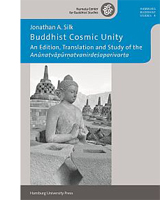 The "Anūnatvāpūrṇatvanirdeśaparivarta" is a short Mahāyāna sūtra extant in its entirety only in Chinese translation. To judge from its use as a proof-text in the seminal philosophical treatise "Ratnagotravibhāga", which quotes roughly half of the sūtra, it is a fundamental scripture expressing ideas about the unitary nature of saṁsāra and nirvāṇa, and each individual’s innate capacity for awakening, called in this text and elsewhere ‘tathāgatagarbha,’ ‘embryo of the tathāgatas.’ Although the text has hitherto drawn the attention primarily of Japanese scholars, this is the first critical edition of the sūtra, aligning its Chinese text with the available Sanskrit, offering a richly annotated English translation, a detailed introduction which places the work in its historical and doctrinal context, and a number of appendices exploring key notions, providing a reading text shorn of annotation, and enumerating the prolific quotations of the work found in Chinese Buddhist literature. This volume is thus an important contribution to studies of developing Mahāyāna Buddhism, Buddhist doctrine and the textual history of scriptures.
The "Anūnatvāpūrṇatvanirdeśaparivarta" is a short Mahāyāna sūtra extant in its entirety only in Chinese translation. To judge from its use as a proof-text in the seminal philosophical treatise "Ratnagotravibhāga", which quotes roughly half of the sūtra, it is a fundamental scripture expressing ideas about the unitary nature of saṁsāra and nirvāṇa, and each individual’s innate capacity for awakening, called in this text and elsewhere ‘tathāgatagarbha,’ ‘embryo of the tathāgatas.’ Although the text has hitherto drawn the attention primarily of Japanese scholars, this is the first critical edition of the sūtra, aligning its Chinese text with the available Sanskrit, offering a richly annotated English translation, a detailed introduction which places the work in its historical and doctrinal context, and a number of appendices exploring key notions, providing a reading text shorn of annotation, and enumerating the prolific quotations of the work found in Chinese Buddhist literature. This volume is thus an important contribution to studies of developing Mahāyāna Buddhism, Buddhist doctrine and the textual history of scriptures.
Jonathan A. Silk, An Edition, Translation and Study of the "Anūnatvāpūrṇatvanirdeśaparivarta". Hamburg Buddhist Studies 4, Hamburg: Hamburg University Press 2015. The book is freely available (PDF).
Band 3: A Distant Mirror – Articulating Indic Ideas in Sixth and Seventh Century Chinese Buddhism
Band 3: A Distant Mirror – Articulating Indic Ideas in Sixth and Seventh Century Chinese Buddhism
herausgegeben von Lin Chen-kuo und Michael Radich
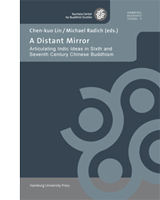 In this book, an international team of fourteen scholars investigates the Chinese reception of Indian Buddhist ideas, especially in the sixth and seventh centuries. Topics include Buddhist logic and epistemology (pramāṇa, yinming); commentaries on Indian Buddhist texts; Chinese readings of systems as diverse as Madhyamaka, Yogācāra and tathāgatagarbha; the working out of Indian concepts and problematics in new Chinese works; and previously under-studied Chinese evidence for developments in India. The authors aim to consider the ways that these Chinese materials might furnish evidence of broader Buddhist trends, thereby problematizing a prevalent notion of “sinification”, which has led scholars to consider such materials predominantly in terms of trends ostensibly distinctive to China. The volume also tries to go beyond seeing sixth- and seventh-century China primarily as the age of the formation and establishment of the Chinese Buddhist “schools”. The authors attempt to view the ideas under study on their own terms, as valid Buddhist ideas engendered in a rich, “liminal” space of interchange between two large traditions.
In this book, an international team of fourteen scholars investigates the Chinese reception of Indian Buddhist ideas, especially in the sixth and seventh centuries. Topics include Buddhist logic and epistemology (pramāṇa, yinming); commentaries on Indian Buddhist texts; Chinese readings of systems as diverse as Madhyamaka, Yogācāra and tathāgatagarbha; the working out of Indian concepts and problematics in new Chinese works; and previously under-studied Chinese evidence for developments in India. The authors aim to consider the ways that these Chinese materials might furnish evidence of broader Buddhist trends, thereby problematizing a prevalent notion of “sinification”, which has led scholars to consider such materials predominantly in terms of trends ostensibly distinctive to China. The volume also tries to go beyond seeing sixth- and seventh-century China primarily as the age of the formation and establishment of the Chinese Buddhist “schools”. The authors attempt to view the ideas under study on their own terms, as valid Buddhist ideas engendered in a rich, “liminal” space of interchange between two large traditions.
Lin, Chen-kuo und Michael Radich [Hrsg.], A Distant Mirror – Articulating Indic Ideas in Sixth and Seventh Century Chinese Buddhism. Hamburg Buddhist Studies 3, Hamburg: Hamburg University Press 2014. Das Buch ist frei als PDF verfügbar.
Band 2: The Dawn of Abhidharma
Band 2: The Dawn of Abhidharma
von Bhikkhu Anālayo
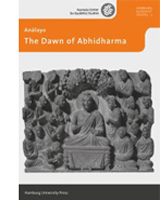 This book is a companion to Bhikkhu Anālayo’s previous study of the Genesis of the Bodhisattva Ideal. In the present book he turns to another important aspect in the development of Buddhist thought: the beginnings of the Abhidharma. Anālayo shows that the two main modes generally held in academic circles to explain the arising of the Abhidharma – the use of lists (mātrḳā) and the question-and-answer format – are formal elements that in themselves are not characteristic of Abhidharma thought. Going beyond the notion that the coming into being of the Abhidharma can be located in such formal aspects, he shows how the attempt to provide a comprehensive map of the teachings gradually led to the arising of new terminology and new ideas. He identifies the notion of the supramundane path as an instance where fully fledged Abhidharma thought manifests in the discourses. Anālayo concludes that what characterizes the Abhidharma is not the mere use of dry lists and summaries, but rather a mode of thought that has gone further (abhi-) than the Dharma taught in the early discourses in general.
This book is a companion to Bhikkhu Anālayo’s previous study of the Genesis of the Bodhisattva Ideal. In the present book he turns to another important aspect in the development of Buddhist thought: the beginnings of the Abhidharma. Anālayo shows that the two main modes generally held in academic circles to explain the arising of the Abhidharma – the use of lists (mātrḳā) and the question-and-answer format – are formal elements that in themselves are not characteristic of Abhidharma thought. Going beyond the notion that the coming into being of the Abhidharma can be located in such formal aspects, he shows how the attempt to provide a comprehensive map of the teachings gradually led to the arising of new terminology and new ideas. He identifies the notion of the supramundane path as an instance where fully fledged Abhidharma thought manifests in the discourses. Anālayo concludes that what characterizes the Abhidharma is not the mere use of dry lists and summaries, but rather a mode of thought that has gone further (abhi-) than the Dharma taught in the early discourses in general.
Anālayo, Bhikkhu, The Dawn of Abhidharma. Hamburg Buddhist Studies 2, Hamburg: Hamburg University Press 2014. Das Buch ist frei als PDF verfügbar.
Band 1: The Genesis of the Bodhisattva Ideal
von Bhikkhu Anālayo
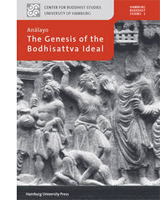 In this book, Bhikkhu Anālayo investigates the genesis of the bodhisattva ideal, one of the most important concepts in the history of Buddhist thought. He brings together material from the corpus of the early discourses preserved mainly in Pāli and Chinese that appear to have influenced the arising of the bodhisattva ideal. Anālayo convincingly shows that the early sources do not present compassionate concern for others as a motivating force for the Buddha’s quest for awakening. He further offers an analysis of the only reference to Maitreya in the Pāli canon, showing that this reference is most likely a later addition. In sum, Bhikkhu Anālayo is able to delineate a gradual genesis of central aspects of the bodhisattva ideal by documenting (1) an evolution in the bodhisattva concept reflected in the early discourses, (2) the emergence of the notion of a vow to pursue the path to buddhahood, and (3) the possible background for the idea of a prediction an aspirant to buddhahood receives from a former buddha.
In this book, Bhikkhu Anālayo investigates the genesis of the bodhisattva ideal, one of the most important concepts in the history of Buddhist thought. He brings together material from the corpus of the early discourses preserved mainly in Pāli and Chinese that appear to have influenced the arising of the bodhisattva ideal. Anālayo convincingly shows that the early sources do not present compassionate concern for others as a motivating force for the Buddha’s quest for awakening. He further offers an analysis of the only reference to Maitreya in the Pāli canon, showing that this reference is most likely a later addition. In sum, Bhikkhu Anālayo is able to delineate a gradual genesis of central aspects of the bodhisattva ideal by documenting (1) an evolution in the bodhisattva concept reflected in the early discourses, (2) the emergence of the notion of a vow to pursue the path to buddhahood, and (3) the possible background for the idea of a prediction an aspirant to buddhahood receives from a former buddha.
Anālayo, Bhikkhu, The Genesis of the Bodhisattva Ideal. Hamburg Buddhist Studies 1, Hamburg: Hamburg University Press 2010. Book Review in the Journal of the Oxford Centre for Buddhist Studies 1, 2011, S. 216–221. Das Buch ist frei als PDF verfügbar.
